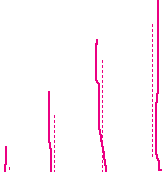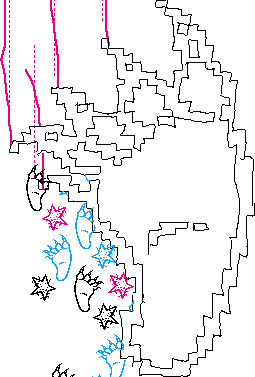| (1) GENERATION FLASH (2) FAQ (3) UTOPIA IN SOFWARE (4) THE UNBEARABLE LIGHTNESS OF FLASH (5) ART, MEDIA AND SOFTWARE ART (6) POSTSCRIPT LEV MANOVICH, 2002 (7) WEBSITES, THE ART OF OUR TIMES MILTOS MANETAS , 2002 (8) FLASH IS POPTECH PETER LUNENFELD, 2001
The Unbearable Lightness of FLASH by Lev Manovich
[Tirana Biennale 01 Internet section (www.biennale.net) was organized by Miltos Manetas / Electronic Orphanage. The exhibition consisted from a few dozen projects by Web designers and artists, many of whom work in Flash or Shockwave. Manetas commissioned me, Peter Lunenfeld, and Norman Klein to write the analysis of the show. This text is my contribution; many ideas in it developed out of the conversations the three of us had about the works in the show. The names in brackets below refer to the artists in the show; go to the show site to see their projects.]
Biology. Flash artists are big on biological references. Abstract plants, minimalist creatures, or simply clouds of pixels dance in patterns which to a human eye signal “life’” (Geoff Stearns: deconcept.com, Vitaly Leokumovich: unclickable.com, Danny Hobart: dannyhobart.com; uncontrol.com) Often we see self-regenerating systems. But this is not life as it naturally developed on Earth; rather, it looks like something we are likely to witness in some biotech laboratory where biology is put in the service of industrial production. We see hyper accelerated regeneration and evolution. We see complex systems emerging before our eyes: millions of years of evolution are compressed into a few seconds. There is another feature that distinguishes life a la Flash from real life: the nonexistence of death. Biological organisms and systems are born, they develop, and eventually they die. In short, they have teleology. But in Flash projects life works differently: since these projects are loops, there is no death. Life just keeps running forever – more precisely, until your computer maintains Net connection.
Amplification: Flash aesthetics and Computer Games. Abstract ecosystems in Flash projects have another characteristic that makes playing so pleasurable (Joel Fox). They brilliantly use the power of the computer to amplify user’s actions. This power puts a computer in line with other magical devices; not accidentally, the most obvious place to see it is in games, although it is also at work in all of our interactions with a computer. For instance, when you tell Mario to step to the left by moving a joystick, this initiates a small delightful narrative: Mario comes across a hill; he starts climbing the hill; the hill turns to be too steep; Mario slides back onto the ground; Mario gets up, all shaking. None of these actions required anything from us; all we had to do is just to move the joystick once. The computer program amplifies our single action, expanding it into a narrative sequence. Historically, computer games were always a step ahead from the general human computer interface. In the 1960s and 1970s users communicated with a computer using non-graphical interfaces: entering the program onto a stack of punch cards, typing on a command line, and so on. In contrast since their beginnings in the late 1950s, computer games adopted interactive graphical interface – something that only came to personal computers in the 1980s. Similarly, today’s games already use what many computer scientists think will be the next paradigm in HCI: active amplification of user’s actions. In the future, we are told, agent programs would watch our interactions with a computer, notice the patterns, and then automate many tasks we do regularly, from backing up the data at regular intervals to filtering and answering our email. The computer would also monitor our behavior and attention level, adjusting its behavior accordingly: speeding up, slowing down, and so on. In some ways this new paradigm is already at work in some applications: for instance, a Internet browser offers us the list of sites relevant to the topic we are searching on; Microsoft Office Assistant trying to guess when we need help. However, there is a crucial problem with moving to such active amplification across the whole of HCI. The more power we delegate to a computer, the more we lose control over what it is doing. How do we know that the agent program identified a correct pattern in our daily use of email? How do we know that a commerce agent we send on the Web to negotiate with other agents the lowest price for a product was not corrupted by them? In short, how do we know that a computer amplified our actions correctly? Computer games are games, and the worst that may happen is that we lose. Therefore active amplification is present in practically every game: Mario embarking on mini-narratives of its own with a single move of a joystick; troops conducting complex military maneuvers while you directly control only their leader in Rainbow Six; Lara Craft executing whole acrobatic sequences with a press of a keyboard key. (Note that in “normal” games this amplification does not exist: when you move a single figure on a chessboard, this is all that happens; your move does not initiate a sequence of steps.) Flash projects heavily use active amplification. It gives many projects the magical feeling. Often we are confronted with an empty screen, but a single click brings to life a whole universe: abstract particle systems, plant-like outlines, or a population of minimalist creatures. The user as a God controlling the universe is something we also often encounter in computer games; but Flash projects also give us the pleasure of creating the universe from scratch. The active amplification is not the only feature Flash projects share with games. More generally, as Peter Lunefeld suggested, computer games are for Flash generation what movies were for Warhol Cinema and TV colonized the unconscious of the previous generations of media artists who continue to use the gallery as their therapy coach, spilling bits and pieces of their childhood media archives in public (for instance, Douglas Gordon). Flash artists are less obsessed with commercial time-based media. Instead, their iconography, temporal rhythms, and interaction aesthetics come from games (Mike Calvert: mikecalvert.net). Sometimes the user participation is needed for the Flash game to work; sometimes the game just plays itself (UTOPIA by futurefarmers.com; dextro.org).
Flash versus Net Art.
Now this utopia is over. The power structure of the global Empire has become clear, and the demographics of Tirana Biennale 01 Internet section reflected this perfectly. Many artists included in Tirana Biennale 01 Internet exhibition work in key IT regions of the world: San Francisco (Silicon Valley), New York (Silicon Alley) and Northern Europe. What happened? In the mid 1990s, net art relied on simple HTML that run well on both fast and slow connections – and this is enabled active participation of the artists from the East. But the subsequent colonization of the Web by multimedia formats – Flash, Shockwave, QuickTime, and so on – restored the traditional West/East power structure. Now Web art requires fast Internet connections for both the artist and the audiences. With its slow connections, East is out of the game. The Utopia is over; welcome to the Empire. (Tirana Biennale 01 did include one artist from China who contributed a beautiful animation of martial arts fighters. But we never found who he was. All we knew about him was his email address: zhu_zhq@sohu.com. Maybe he did not even live in China.)
|
![]()
 |
 |
 |